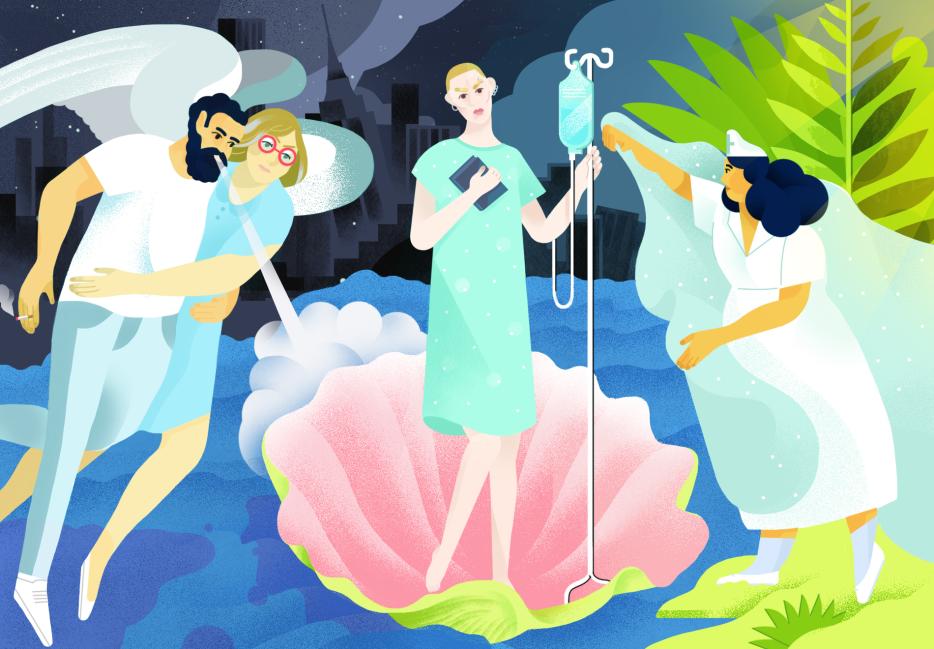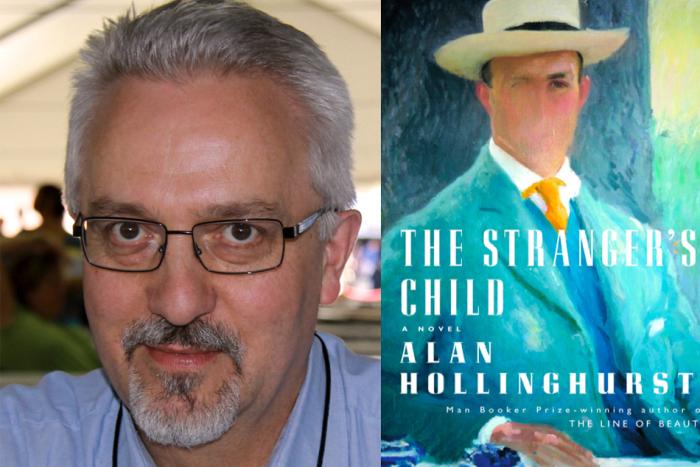Tijuana, Mexico, 1997.
Kathy Acker has always been small, physically speaking, but now, in this cancer clinic in Mexico, during the last week of her life, she’s almost disappeared. Her hair, kept short for much of her life, has stopped growing. No longer coloured or bleached, it’s reverted to its natural mousy brown. Acker’s voice, with a thick Manhattan accent that endured no matter how far she strayed from New York, has lost much of its strength. While she could once magick her jagged prose into something sublime at readings or on recordings, she now speaks little. Her muscles, painstakingly sculpted, have atrophied, distorting the elaborate tattoos that cover them. She looks, somehow, younger. Her clothes, the famously outré and outsized Comme des Garçons and Vivienne Westwood outfits, have vanished, replaced by a garment that recalls, with sad precision, the “puke green” paper shift the protagonist of her novel, Don Quixote, wears while undergoing an abortion: “This was her armor,” Acker wrote. “She had chosen it specifically, for she knew that this world’s conditions are so rough for any single person, even a rich person, that person has to make do with what she can find; this’s no world for idealism.”
Acker was always armoured. Despising the privileged yet oppressive Upper East Side household she was raised in, she turned her back on her family as soon as she could, constructing and cultivating a seemingly impervious persona—outlaw, feral, sexually voracious, fearless, irresponsible, raging, indifferent to all propriety. Her genre-defying fiction, from the mail-art chapbook The Childlike Life of the Black Tarantula to incendiary novels like Blood and Guts in High Schooland Empire of the Senseless, were ways to think against every repression, to overturn the worlds—and words—of parents, gender, the academy, rationality, the traditional novel. Writing could subvert the strictures of identity. It could anatomize sexual power. “The only reaction against an unbearable society,” she wrote in an essay about Goya and Caravaggio, “is equally unbearable nonsense,” an aperçu precisely summarizing her own aesthetic and political ambitions. Like her lodestar, Jean Genet, Acker constantly dwelt in opposition.
Her books were also fever dreams of escape and reinvention, and Acker’s own forbidding physical appearance—she could look, alternately, like a deranged kewpie doll, a pirate from the future, an alien courtesan—embodied such transformations. She spent years turning her body, simultaneously a source of pain and possibility in her work and life, into a protective carapace. She began bodybuilding seriously in her mid-30s, and her hairstyles and make-up were severe, sometimes shocking (her bright red lipstick, she said, in an interview with Bomb, “looks like cunt color after fucking”). Over the years, and before such things were really fashionable, she acquired various piercings, seven in total, and covered her back and arms in tattoos. These weren’t just confrontational decoration, but like her cutting-edge clothing, a kind of dazzle camouflage. It was the costume of a rock star or performance artist and distinguished her entirely from other writers. It insisted, in fact, that she wasn’t only a writer.
In a sense, Acker’s novels were written to be performed, and she likewise performed her life as if she had written it. This could be burdensome. “Being Kathy Acker,” the media theorist (and, briefly, Acker lover) McKenzie Wark says, “was not an easy thing.” She pulsed with a contradictory charisma—seductive, funny, fiercely intelligent and capable of extraordinary intimacy, she could also be cripplingly vulnerable, demanding and competitive. The hard-boiled image she strenuously devised masked a more fragile neurotic. Her narrators are almost always child-women, and she herself often behaved like a child—doing what she wanted, when she wanted, how she wanted. Friends and lovers could be dispatched mercilessly, for the most insignificant insult, the perception of betrayal, because they were no longer useful to her. “She was very needy and lonely,” her oldest and closest friend, the San Diego writer Mel Freilicher, told me, “but she was always testing people and pushing them away without even wanting to.”
“Unlike most medical stories, all the horror in this one occurs in its beginning,” Acker wrote. “Gradually there will come an end to the fear.”
Acker’s inability, or unwillingness, to compromise over anything, from the difficulty of her writing to the kinds of foods she ate, finally led her to this point in Mexico. In April, 1996, while living in San Francisco, Acker was diagnosed with breast cancer. Told to choose between a lumpectomy with radiation or a mastectomy without radiation, Acker decided on the latter, and three weeks later, underwent a double mastectomy (she said she didn’t want to have only one breast and she refused reconstruction). It was a characteristically swift, radical response. “I thought, she ‘cut them off’ the way she cut people off and out of her life,” remembers Lynne Tillman, a close friend of Acker’s when they were both young writers in New York, but with whom Acker later fell out. During the mastectomy, Acker’s surgeon found that the cancer had spread to her lymph nodes, and recommended additional chemotherapy. Lacking medical insurance and long disgusted with Western medicine—suffering from excruciating pelvic inflammatory disease in her 20s and also having several abortions, Acker had spent a lot of time doctor’s offices—she refused. Instead, she sought alternative treatment, surrounding herself with acupuncturists, herbalists, astrologers, psychics. Diligently, obsessively, she followed their post-op instructions for months: a diet entirely free of alcohol, dairy, and gluten; daily hours of yoga and meditation; regular powdered herbal supplements (which she lugged around, along with vitamins, in a full-sized suitcase). Under the guidance of Georgina Ritchie, a “certified Louise Hay healer,” she even experimented with past-life channeling. “I’m basically a New Age writer,” she once said to friend and writer, Robert Glück, and that sentiment no longer seemed a joke.
Acker’s closest friends were concerned and frightened; they repeatedly, desperately urged her to try chemotherapy. She ignored them, or fought with them, and then, finally fed up, left them and San Francisco both for London, where she had lived for several years in the ’80s. In The Guardian in January 1997, she published “The Gift of Disease,” an essay about her illness in which she declared that those alternative therapies had saved her. She believed she was cured. “Unlike most medical stories, all the horror in this one occurs in its beginning,” she wrote. “Gradually there will come an end to the fear.”
The fear had not ended. Or at least Acker didn’t reveal her increased anxiety, even as she became more infirm. By the summer she was constantly ill—indeterminate digestive problems, occasional bouts of pneumonia—but she insisted she only had a persistent cold and refused, as usual, to see a doctor. After the mastectomy and the other treatments, she had had no further medical tests done. At a performance at Chicago’s Museum of Contemporary Art, which would turn out to be her last public appearance, she gamely performed songs from the operetta Pussy King of the Pirates alongside The Mekons, only to be carried off stage after collapsing halfway through the show. She returned to San Francisco, checking into a decrepit motel in the Tenderloin. From there, she called Matias Viegener, an artist and writer who taught at CalArts. Viegener, who was 38, had met Acker ten years previously, at a party at Dennis Cooper’s place in Los Feliz. He was a great admirer of her work, and charmed by her surprising shyness—at the party, she stood apart from the rest of the guests, absently inspecting Cooper’s bookshelves. He approached her and introduced himself. They quickly became close, closer than either expected. By virtue of physical distance or lack of sexual attraction (Viegener is gay), their relationship never succumbed to the insecurity and competitiveness that characterized so many of Acker’s relationships. After her death, Viegener wrote that he considered Acker one of only two geniuses he’d met his life. He was unfailingly patient with her, even as Acker’s other friends were increasingly becoming the opposite. He offered to drive up the next day from Los Angeles and collect her.
When Viegener arrived at the motel in the late afternoon, two of Acker’s other friends, the artists Aline Mare and Sharon Grace, were there. Dehydrated and unbearably thin, Acker looked awful. The three of them implored Acker to go to the hospital, and so weak now, she finally relented. Late that evening, an ambulance took Acker to Ralph Davies Medical Center, and she was admitted on October 25. That night, the doctors at Ralph Davies took X-rays that revealed the cancer had in fact metastasized—Acker now had advanced cancer of the liver, pancreas, spleen, and lungs. The doctors told her she had maybe a week to live. But even after she grudgingly acknowledged that the “whitecoats” (Acker’s customary term for them) might be right about the cancer’s return, she refused to believe that palliative care was her only remaining option. In “The Gift of Disease,” Acker wrote that conventional medicine had reduced her to “a body that was only material, a body without hope and so, without will, to a puppet who, separated by fear from her imagination and vision, would do whatever she was told.” Even so frail, she had not lost hope, nor would she abandon any sense of control. Even in the face of death, Acker could never, would never, be told what she could or couldn’t do. To her doctors’ irritation, she brought in some of her healers—“the witch doctors,” Viegener calls them now, without malice—and, after consulting with them, decided she would pursue more experimental care in Mexico. “Kathy had profound willpower,” Viegener says. “It’s rare I meet anyone with more willpower than her. She had accepted that the cancer had come back, but she was certain she’d recover with more alternative treatment.” Other friends were more critical. Ira Silverberg, who had, at various times, been Acker’s publicist, agent, and publisher, was certain she wanted to die. “It was her exit strategy,” he says. “She was no longer as successful as she had been. Many friends had abandoned her. She wanted out.”
Acker left Ralph Davies on November 1, in a rented van with Viegener driving and a nurse, who was also a Buddhist nun, administering morphine to Acker, who reclined in the back. They arrived in Tijuana at American Biologics, a self-described holistic integrated clinic, in one day. American Biologics (later renamed the International Bio Care Hospital) was clean and comfortable but not luxurious, a low-slung building just off of Tijuana’s main strip, the aptly named Avenida Revolución. Its most distinctive characteristic was a kind of charged intensity—every patient there had late-stage cancer. The clinic was both their last hope and, for almost all, their last station on earth. Viegener describes it as a world apart, not unlike the sanitarium in Thomas Mann’s Magic Mountain. They put Acker in Room 101. “Is there nothing that woman can’t turn into a literary reference?” comic artist Alan Moore later quipped, referring to the similarly named torture chamber in George Orwell’s 1984.
“Why can’t you call her, Kathy?” Viegener asked. Exasperated and exhausted, her voice trembling, Acker finally said, “Because my sister … is the president … of her tennis club!”
Acker’s treatment, however, was far from torturous. The nurses didn’t speak much English, but were warm and empathetic. The clinic prepared its own organic, often quite delicious, food. Acker could no longer walk, but Viegener and other visitors would wheel her out to sit in the sun on the rooftop patio. Her doctor, Rodrigo Rodriguez, a jovial, bearish man who had also treated (unsuccessfully) the actor Steve McQueen, prescribed a course of herbal extracts and Gerson therapy, a detoxification and diet regimen. The only constant in the many different apartments Acker lived in throughout her adult life had been her vast library and extensive collection of stuffed animals, and here too she had a few books and her beloved Ratski, a tattered plush rat she slept with. Instead of morphine, the hospital used an herbal analgesic that staff administered intravenously. She never complained about pain.
Visitors started arriving almost immediately: her oldest friends, David and Eleanor Antin, the conceptual poet and artist respectively, and Mel Freilicher, from San Diego. Silverberg and Amy Scholder, another friend who had edited and published Acker, flew in from New York, as did Sylvère Lotringer, the founder of Semiotext(e) and another former lover of Acker’s. Those who couldn’t come in person, such as Tillman and the writers Jeanette Winterson and Neil Gaiman, phoned. The conversations in Room 101 were, for the most part, tender and joyous, with much talk about books and gossip about friends and lovers. The Antins had brought a CD of La Traviata, and Viegener Philip Glass’s Solo Piano and Felix Maria Woschek’s Mystic Dance, an album of Hindu bhajans and Islamic mantras. Acker played the last two CDs constantly—a meditative, almost unearthly, soundtrack. Frielicher delivered books that Acker asked for—John Le Carré’s Tinker, Tailor, Soldier, Spy, Gershom Scholem’s book on the Kabbalah—while Viegener gave her a copy of I Love Dick, Chris Kraus’s just published and controversial memoir-cum-novel about her obsession with cultural theorist Dick Hebdige. When Hebdige surprised everyone by dropping in to visit, Acker deftly hid the book under her pillow.
Towards the end, Amy Scholder implored Acker to phone her half-sister, Wendy, who was then living in Massachusetts. Acker refused. “She’s your closest living family,” Scholder said. “You have to tell her that you’re so sick.” Acker still refused, even when Viegener pled the case. “Why can’t you call her, Kathy?” Viegener asked. Exasperated and exhausted, her voice trembling, Acker finally said, “Because my sister … is the president … of her tennis club!” It was a comical, if unbearably melancholy, moment—as if, Acker was saying, anyone that was the president of a tennis club, of all things, could possibly grasp who she was, how she had lived her life, and now, finally, how she had arrived at this place and moment. To call would add so much more grief to the situation, for her and for what remained of her family. Acker told Scholder and Viegener that they shouldn’t call either.
Until the last week of her life, Acker was still convinced she would survive, and everyone knew not to say otherwise. But by the week of Thanksgiving, her condition rapidly declined. She stopped breathing and was resuscitated, and thereafter could no longer breathe unassisted. She stopped eating solid foods. Her body shrunk even more. In one of her last lucid conversations with Viegener, they talked briefly about her literary legacy. “I’ve said I what I needed to say,” Acker said. “I can accept dying. I want to stay in the world, but I’ve made the work that was in me to make. I’ve accomplished something.”
On Thanksgiving Day, Viegener asked if she wanted to eat anything. She said no. Two days later, the L.A.-based photographer and video artist Connie Samaras, Viegener’s best friend and someone with whom Acker had enjoyed a flirtatious relationship, called him and asked when she should visit. He told her to come down right away, and Samaras arrived around four that afternoon, intending to only spend a couple of hours. But Viegener, who had been sleeping on a second bed in Acker’s room, was exhausted and asked that she stay longer. While he napped, Samaras sat on Acker’s bed, whispering soothingly to her. While Acker could barely speak, Samaras sensed that Acker wanted, needed, some kind of sexual contact. “I just started touching Kathy everywhere,” she says, “on her breast, on her pussy. It was sexual and comforting. I knew she wanted to be touched like that. Kathy was very sensual.” In response, Acker gently kissed the air.
At 11 p.m., Samaras roused Viegener. On the bed, Samaras and Viegener lay on either side of Acker, holding her hands, calmly caressing her face. The Philip Glass CD continued to play. The three spoke little, but Acker’s gaze moved slowly between Samaras and Viegener. Her eyes eventually closed, her breath became more erratic. Samaras told her that it was okay, that she could let go. Two hours later, at 1 a.m. on December 1, 1997, Acker whispered her last words, “Up, up, up”—requesting that her bed be adjusted—and then her heart finally stopped.
In Eurydice in the Underworld, a theatrical fragment that was the last thing Acker published, she cast herself, not surprisingly, as Electra. In the London Review of Books obituary that the film theorist Peter Wollen, another Acker ex, wrote, he said that "myth is a way of exorcising the fear of death itself," and Acker did die, fearlessly it seemed, and absolutely on her own terms. “She looked beautiful,” Viegener remembers. “It was a beautiful death, like a 19th-century death from TB.” After the doctors at American Biologics confirmed Acker’s death, her body was washed and prepared for cremation. Viegener and Samaras took it upon themselves to remove the five piercings that remained. It would be a week before the cremation, so they decided to return home. They took a cab to the border and walked across and caught the train back to San Diego. Their car was filled with college students, prostitutes, and young Marines, everyone drunk or high or both, a gaudy, debauched procession that Viegener thought would have pleased Acker. As they traveled up along the ocean and then into San Diego, a glorious sunrise filled the harbour with light. “It was like coming out of the underworld,” Viegener says, “and into the real world.”






